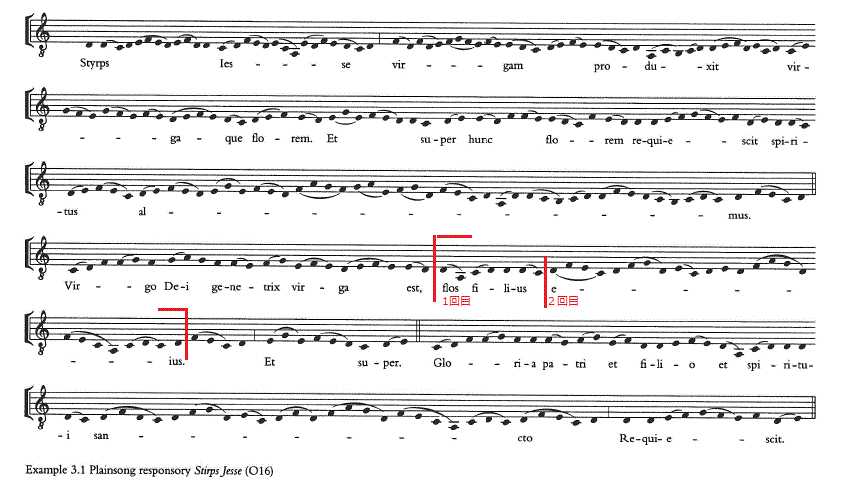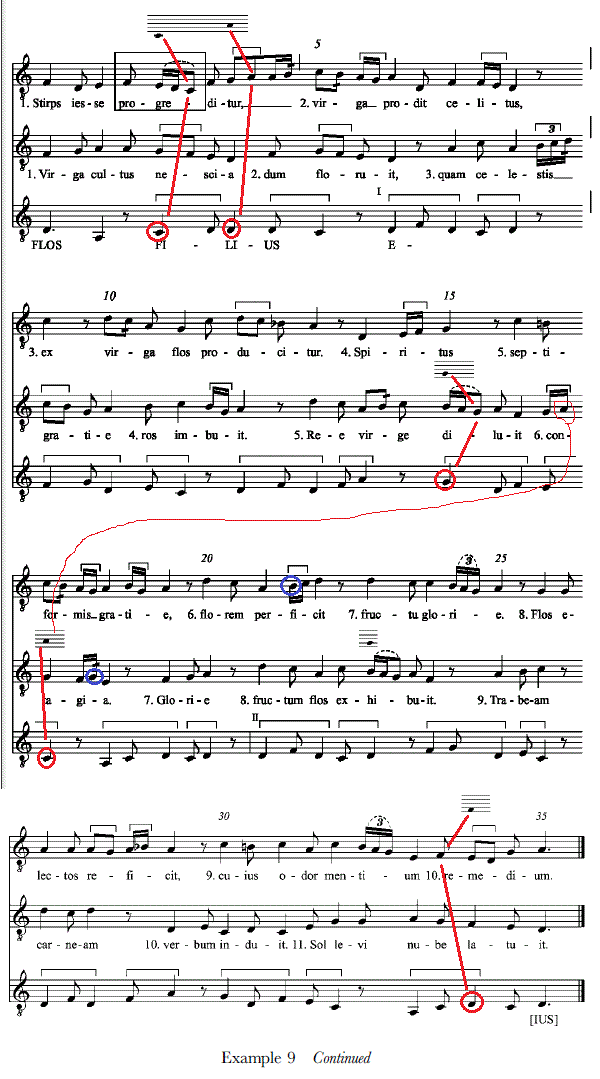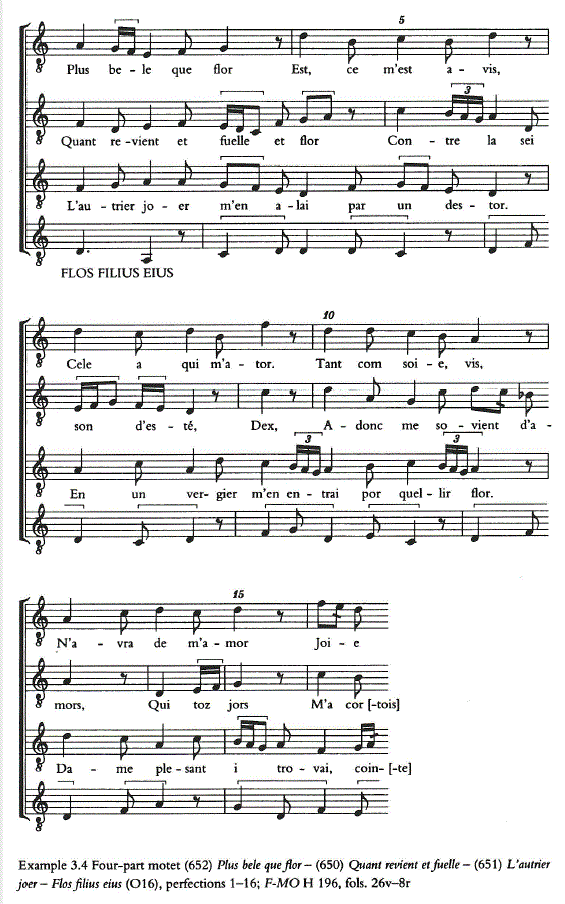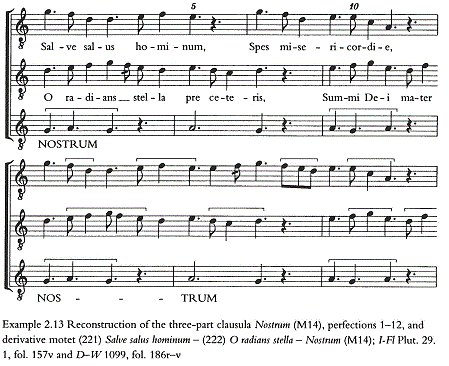| French Motet in the Thirteenth
Century4 |
| 音楽エッセイのページへ戻る | 初期多声音楽 | St.マーシャル楽派へ |
| Leoninのページへ | ノートルダム楽派(conductus)のページへ |
ペロタン(Viderunt Omnes) |
| ペロタン(Alleluja Nativitas) | ペロタン Clausulaのページ | まうかめ堂さんのページへ |
| substitute clausulaのページへ | 中世音楽のページへ | 前のページへ |
| 次のページへ |
| The french motet the French language and motet Motets in French, or adaptations from clausulae and pre-existent Latin motets, involve many of the same procedures found in the Latin tradition. Irregularity of musical phrase and poetic line-length are hallmarks of the French as well as the Latin motet. Although in principle the composer could vary the number of syllables in a poetic line written to pre-existent music by repeating pitches, this hardly ever happened. In cases where French motets are modelled on Latin-teχted originals, the composer of the French motet respected his model as much as the creator of the Latin motet adhered to the structure of his clausula prototype.1 Even when composers began writing motets that did not depend on polyphonic models but struck out from a plainsong, poetic lines of irregular length remained the norm. Rhyme was a different matter. Here a number of opportunities presented themselves. Duplicating the Latin rhyme-scheme or ignoring it completely were the simplest and most extreme. More interesting is the possibility of contradicting the rhyme-scheme in motets that reflected some original patterning in the clausula model。 フランス語のモテット、あるいはクラウズラや既存のラテン語モテットからの適合は、ラテン語の伝統において見出される同じ手順を多く含んでいる。音楽のフレーズや詩の行長の不規則性は、ラテン語モテット同様、フランス語モテットの目印となる。原則として、作曲者は、もともと存在していた音楽につけられた詩行において、音節の数を変化させることができたが、こうしたことはほとんど行われていない。フランス語モテットがラテン語オリジナルにモデル化される場合、フランス語モテットの作曲者は彼のモデルを、クラウズラの原型構造に執着したラテン語モテットの創造者のように敬ったことであった。作曲者がポリフォニー・モデルには頼らず、プレインソングから作り出したモテットを書き始めた時でさえ、不規則な長さの詩が残っていた。韻はまた別の問題であり、それ自身に多くの機会が存在した。ラテン語の押韻計画やそれを完全に無視することの重複は、もっとも単純かつ極端である。より興味深いことは、クラウズラモデルにおけるオリジナルパターンを反映したモテットにおける押韻計画の矛盾の可能性である。 We may begin our exploration of the derivation of a French motet from the tradition of the clausula and Latin motet with a family of motets based on one of the most popular tenors: Flos filius eius (016). Many combinations of text and music arose out of the Flos filius plainsong. It is almost impossible to construct a simple chronology for this group of compositions. The three-part clausula is found in a single source only, and not embedded in an organum setting.2 The clausula might therefore not be a source for the motet, but simply a notational sketch. The French motet that forms part of the family, (650) Quant revient et fuelle ― (651) L'autrierjoer一Flos filius eius(016), makes use of a refrain in its motetus. This fact might well suggest that the motet with French texts might depend directly on the clausula. Both the French piece, and the Latin − (647) Stirps Jesse− (648) Virga・cultus 一 Flos Filius eius (016)−could therefore descend independently from the same clausula. These uncertainties suggest that the music should be discussed in a way that avoids making simple assumptions about the history of the motet family, and that eχamines the nature of the relationship between clausula, French motet and Latin motet as independent, but related, entities. 我々は、最もポピュラーなテノールの一つ、Flos filius eius (016)をベースとしたモテット族とともに、クラウズラやラテン語モテットの伝統からフランス語モテットが派生した経緯の説明から始めようと思う。このプレインソングには、多くの歌詞と音楽の組み合わせがある。このグループの作曲上の単純な時系列を作り上げることはほとんど不可能である。3声クラウズラはひとつのソースのみに見られるが、オルガヌムには埋め込まれていない。クラウズラはそれゆえに、モテットのソースではなく、単なる記譜のためのスケッチであろう。モテット族を形成するひとつであるフランス語モテット、Quant revient et fuelle ― (651) L'autrierjoer一Flos filius eius(016)は、そのmotetusにrefrainを使用している。この事実は、フランス語歌詞であるモテットが、直接クラウズラにその起源があることを示唆しているように思える。Quant revient et fuelle ― (651) L'autrierjoer一Flos filius eius(016)とラテン語作品 (647) Stirps Jesse− (648) Virga・cultus 一 Flos Filius eius (016)の両者は、それゆえ、同じクラウズラから独立に作られてきたと言えよう(訳注;Frobenius はrefrainの旋律の存在とEIUSにおけるtenorのメリスマの繰り返しを、フランス語モテットのpriorityの証明として引用しているhttp://machikun.la.coocan.jp/contrafactaand4.htm)。こうした不確実性は、音楽が、モテット族の歴史について単純な仮定を作ることを避けることや、クラウズラ、フランス語モテット、ラテン語モテット(それぞれは独立しているが全体としての関連も持っている)の関係の性質を調べるやり方の中で議論されてきたことを示唆する。 We may begin with the plainsong responsory on which the complex of motets is based: Stirps Jesse virgam produxit. Example 3.1 is an edition. This responsory is prescribed in thirteenth-century Parisian liturgies as the siχth at Matins for the feast of the Annunciation of the Blessed Virgin (25 March) and as the Vespers responsory for the Assumption of the Blessed Virgin (15 August).3 Organum settings survive in both two and three parts, and there are clausulae on Flos filius eius, Stirps Jesse,virgo and Genetrix virga . Of the eleven clausulae on Flos filius eius、 four have a reflection in the motet repertory.4 我々は、モテット複合体がベースとしたplainsong responsory Stirps Jesse virgam produxitから始めてみたい(Example 3.1)。このresponsoryは、13世紀のパリ風典礼でにおいて使われていた。このresponsoryによるオルガヌムのセッティングは2声、3声のものが残されている。そして、Flos filius eius, Stirps Jesse,virgo と Genetrix virga によるクラウズラがある。Flos filius eiusによる11のクラウズラのうち、4つはモテットレパートリーに影響を与えている。  Example 7 consists of an edition of the beginning of the three-part clausula Flos filius eius(016) and its derivative Latin motet (647) Stirps Jesse - (648) Virga cultus 一Flos filius eius(016). We will return to the structure of the poetry later. The first thing to observe about the clausula is the phrase-structure of the triplum and duplum. It would have been difficult, if not impossible, to have constructed a conductus-motet with homorhythmic upper parts out of them. The two voice were constructed so as to avoid any simultaneous cadence before the end of the movement . The phrases of the duplum are constructed as follows: 6Perfection + 6P + 6P + 2P + 4P + 2P + 2P + 8P. Example 7、9は、3声のクラウズラ Flos filius eius(016) と、それから派生した(647) Stirps Jesse - (648) Virga cultus 一Flos filius eius(016)を示している。我々は、後にその詩の構造に戻るだろうが、最初にクラウズラについて観察するのは、そのtriplumとduplumのフレーズ構造についてである。 上声部が均一リズムであるconductus-motet を作り上げることは、不可能ではないが困難なことである。2つの声部は、楽章の終わり前の同時の終止については避けて組み立てられている。この部分のduplumのフレーズは、以下のようである。 6Perfection + 6P + 6P + 2P + 4P + 2P + 2P + 8P.   The regular repetitions of six-perfection phrase-lengths at the beginning of the piece oppose the irregular structure in the second part. This opposition is numerically structural. The three phrases of six perfections constitute exactly half the duration of the duplum; the remaining five phrases make up the second half. The triplum, on the other hand, has the following structure: 8Perfection十IP + 4P + 2P + 4P + 3P + 3P + 4P + 7P (duplumについて)作品の最初の、6perfectionのフレーズ長の規則的な3回の繰り返しは、第2パートの不規則な構造とは対照的である。この対照性は数構造となっている。6perfectionの3つのフレーズは、正確にduplum全体の長さの半分になっている。残りの5フレーズは、後半部分を作っている。triplumは、対照的に以下のような構造になっている。 8Perfection十IP + 4P + 2P + 4P + 3P + 3P + 4P + 7P Apart from a few obvious symmetries (4-2-4; 4-3-3-4 (followed by 7, the sum of the two previous numbers)), the phrase-structure of the triplum is less than clear. But perhaps the most important structural consideration is that the phrase-structures of the duplum and triplum are patterned so that they do not cadence together until the end of the clausula. The wide range of differing phrase-lengths in the two voices, especially in the triplum, is a consistent feature of this particular piece. 明らかなわずかなシンメトリー構造は別として、triplumのフレーズ構造はあまりはっきりしていない。しかしおそらく、構造解析でわかるもっとも重要なことは、duplumとtriplumのフレーズ構造が、クラウズラの最後にいたるまで、終止をしていないことである。両声部における異なったフレーズ長は、特にtriplumにおいてであるが、この特殊な作品の一貫した特徴である。 The tenor structure of this clausula is compleχ. There are two complete cursus. They use the same rhythmic pattern: longa, brevis, longa, brevis, long‘a, brevis rest. But the first cursus begins with a longa ulta mensuram, a dotted crotchet in transcription, followed by another longa,before the beginning of the pattem. Furthermore, the second cursus starts by omitting the fint pitch of the plainsong melisma (see Example 3.3). This second cursus begins immediately with the rhythmic pattern of the first cursus, but reverses two of its pitches. The last four perfections of the piece are made up out of the last five notes of the tenor cursus but in a diffent (cadential) pattern that makes use of further longa ulta mensuram. 0f the thirty-siχ perfections that make up the piece, the repetitions of the tenor cursus divide the clausula into three sections of 17, 15 and 4 perferctions respectively. Constructing a second cursus that mimicked the first, either exactly or in terms of duration, would have been the simplest procedure. The actual pattern seems to be an attempt to unbalance the tenor and to complement the exact binary division of the duplum. The tenor cadences twice only with the duplum and twice with the triplum (perfections 8 and 29). In a piece where the tenor phrases are three perfections long, this is a striking eχample of a sustained and successful attempt at creating three overlapping voice-parts。 このクラウズラのテノールの構造は複雑である。そこには2つの完全なcursusがある。それらは同じリズムパターンであり、longa, brevis, longa, brevis, long‘a, brevis rest(の繰り返し)となっている。しかし、最初のcursusはonga ulta mensuram、すなわちtranscriptionにおいては付点四分音符で始まっている。そして、パターンが開始される前に、longが続いている。さらに、第2cursusはプレインソングメリスマの最初部分が省略されている。第2cursusは第1cursusのリズムパターンで直接開始しているが、そのピッチのふたつが逆になっている。最後の4つのperfectionは、tenorの最後の5つの音符からできているが、longa ulta mensuramを使う異なったパターンである。作品を構成する36perfectionのうち、tenor cursusの繰り返しは、このクラウズラをそれぞれ、17,15,4perfectionに分割する。第2cursusは第1cursusの模倣をするが、それぞれは正確に、もっとも単純な手順を踏んでいることだろう。実際のパターンは、テノールのアンバランスを試み、それをduplumの正確な2分割で補っているのだろう。テノールのカデンツはduplumtとともに2回、triplumとともに(perfection8,29)2回ある。この作品においては、テノールのフレーズは実際には3perfection分長いので、これは3つの重複した声部を作り試みとしては成功した部類に入ることだろう。 In the Latin motet based on the clausula, there are changes to the rhythm of the duplum. These are entirely in line with the procedures for deriving Latin motets from clausulae seen in the previous chapter. There are exceptions to the principle that the model should be followed slavishly. Where the clausula made use of fractio modi, the motet might modify the rhythm of the clausula. This is especially common where semibreves are introduced into the motet and where some ornamental groupings are shifted forward by a breves 5 The modification of instances of fractio modi are clear in this clausula; they usually concern the replacement of longa一breves-longa patterns with three breves, a standard procedure in Mode l fractio modi . When this pattern is taken over in the motet, it often results in a longa followed by two or three semibreves. Eχamples are in perfections 7 (triplum), 11 (motetus), and so on。 クラウズラをベースとしたラテン語モテットにおいて、そこには、duplumのリズムの変化がある。それらは、前章で指摘したように、クラウズラから由来したラテン語モテットに対する手順を伴う行の全体においてである。モデルが隷属的になる原理には例外がある。クラウズラがfractio modiを使うところでは、モテットはクラウズラのリズムを変化させるかもしれない。これは特に、semibrevesがモテットに導入されたり、装飾がbrevesに向かって動いて行ったりするところで一般的である。fractio modiによる変化の例はこのクラウズラにおいて明らかである。これは通常は、longa一breves-longaを3つのbreveに置き換えることに関連している。標準的手順はMode l fractio modi でみられる。このパターンがモテットで引き継がれると、しばしば、longaは2つまたは3つの semibrevesに取って代わられる。例としては、perfection7のtriplumやperfection11のmotetus等に見られる。 Mode l results in clausula phrases consisting of odd numbers of notes; this produces like numbers of syllables in the lines of poetry in the motet. There is even a one-note phrase towards the beginning of the triplum whose single syllable is the first of a longer segment of text. Although the first half of the motetus occupies itself with thirty-three syllables (three equal phrases consisting of eleven syllables each), the second comprises twenty-seven syllables (three lines of three syllables, one of seven and one of eleven). The two temporally equal halves have numbers of syllables that stand in an irrational 11 : 9 proportion. Although the duplum of the clausula is clearly mathematically patterned, the fitting of words does not match the pattern. In the triplum, the one symmetry in the structure of the clausula is partially contradicted in the text setting. The triplum poem, Stirps Jesse is given below with line-lengths, rhymes and phrase-lengths in perfections indicated. クラウズラのフレーズにおけるMode1は、奇数番号の音符より構成されている。これは、詩やモテットの行に同様の音節を生成する。triplumの最初に対する1音節のフレーズがあるが、それは長い音節の最初である。motetusの最初の半分はそれ自身、33シラブルを持っているが、あとの方は27シラブルからなっている。時価が等しいふたつの部分は、11 : 9という不合理な割合の音節数になっているのである。クラウズラのduplumはあきらかに数学的パターンなのであるが、言葉はこのパターンにマッチしていない。Stirps Jesseのtriplumは以下のようになる。 7a Stirps Jesse progreditur, 4 7b Virga prodit celitus 4 Ex 1 7a Virga flos producitur. 4 3b Spiritus 2 7c Septiformls grade 4 5d Florem perficit 3 5c Fructu glorie. 3 7d Flos electos reficit 4 1 1e Cuius odor mentium remedium. 7 The stem of Jesse flourishes and produces a snlaU twig from Heaven, and a flower blooms from this twig. The Spirit of seven-fold grace makes perfect the flower through the fillit of glory. The flower whose fragrance is a remedy of minds restores the elect. We can see the symmetrical phrases of four, three, three and four perfections in lines 6 to 9, These give rise to lines with seven, five, five and seven syllables respectively. But rather than mirroring the ABBA structure of the line-lengths that are derived from the phrase-lengths of the clausula, the rhyme-scheme is ABAB. This is clearly more to do with the overall rhyme-scheme of the poem than with the phrase structure of the clausula. The third line, the single syllable ‘Ex' falls outside a scheme that relies, as does that of lines 6 to 9, 0n pairs of rhymes: ABAB. Again, it seems that consistency in the poem is prized more highly than reflecting the musico-mathematical relationships in the original clausula. (triplumには)第6行目から9行目には、4、3、3、4perfectionの完璧な対称的なフレーズがある。これらは、それぞれ7,5,5、および7つの音節の行に該当する。 しかし、クラウズラのフレーズ長から派生した行長のABBA構造を反映するのではなく、韻スキームはABABである。 これは明らかに、クラウズラのフレーズ構造よりも詩の韻スキームの方がはるかに重要であるということである。 3行目の1音節「Ex」は、6行目から9行目までのように、ABABと韻を踏むスキームとは別個のものである。 詩の一貫性は、元のクラウズラにおける音楽の数学的関係の反映よりも高く評価されているように思える。 Both texts depend heavily for images, in addition to biblical references, on the words of their tenor melisma and on those of the host plainsong. Most obvious is the use of the symbol of a flower, flos, both in its substantive and verbal forms, derived directly from the teχt of the tenor melisma: Flos jilius eius. The symbol of a flower is found both in the triplum and the motetus, three times in the former, and twice, once as a verb, in the latter. As we have seen, this is a common characteristic of poetry in early Latin motets. 両方の歌詞は、聖書への言及加えて、それらのテノールメリスマとホスト・ホストプレインソングの言葉に基づいたイメージに大きく依存している。 花、すなわち”flos”という言葉の使い方にこうしたことが明らかである。花のシンボルはtriplumにもmotetusにも、前者では3回、そして後者では2回+動詞として1回、見出される。これまで見てきたように、これは初期のラテン語モテットにおける詩の共通の特徴である。 Less common is the technique of resorting to the original plainsong for images. Clearly references to virga (twig) in both triplum and motetus refer back to the responsory, as of course do those to flos, which occurs there three times, twice in the responsory itself, and once in the verse from which the tenor melisma is taken. The first four lines of the triplum poem in fact only lightly amplify the first phrase of the responsory。 イメージとしてオリジナルなプレインソングに頼る技術は、それほど一般的ではない。 triplumとmotetusの両方でのvirgaへの言及は、 明らかにresponsoryへ戻ることを推奨している。むろんそれは、3回出現するflosへの言及で、このflosはそれぞれ、responsory自体は2回、そしてテノールのメリスマがそこから取られたverseには1回出現している。triplumの詩の最初の4行は、実際には、responsoryの最初のフレーズを軽く増幅するだけである。 Stirps Jesse virgam produxit virgaque florem(plainsong responsory Stirps Jesse virgam produxitの最初)は、モテットの詩においては、以下のようになる。 Stirps Jesse progreditur。 Virga prodit celitus Ex Virga flos producitur. Apart from the use of the verb progredior and the adverb ‘celitus, this part of the text simply elaborates the plainsong. Celitus is the adverbial cognate of the adjective celestis which is found in the motetus. The two words, as can be seen from a glance at perfections 7 and 8 of Example 3.2, are presented in their respective voice-parts at exactly the same time. One powerful image that is shared between the two motet texts, fructus glorie, seems to have no model either in the plainsong or in the capitulum or lectio that precedes the chant at Assumption Vespers or Annunciation Matins.6 動詞progrediorと副詞のcelitusの使用とは別に、歌詞のこの部分は単純にplainsongをなぞっている。 Celitusは、motetusに見いだされている形容詞celestisの副詞同族体である。 Example9のperfection7と8少し見れば分かるように、celitus、 celestisの2つの単語は、それぞれの音声パートに正確に同時に提示されている。 2つのモテット歌詞fructus glorieの間で共有される1つの強力なイメージは、プレインソングや、Assitption VespersやAnnunciation Matinsでのチャントに先立つ capitulum や lectio において何らモデルを持ってもいないようである。 The fint siχteen perfections of the four-part version in French, (652) Plus bele que flor ― (650) Quant revxent et fuelle一(651) L'autrier joer一flos filius eius, are given as Example 3.4. The three lower parts may then be compared with the Latin version of the piece already discussed. Musically, differences are slight, and the phrase-lengths of both Latin and French poetic line-lengths are the same as the length of phrases in the clausula. Their rhymes, and other structural features, are different. We may begin with a comparison of the two motetus poems: the Latin (648) Virga cultus and the French (651) L'autrier joer. The two texts are given side by side below. The French motetus ends with a refrain, here italicised. フランス語の4声版 (652) Plus bele que flor ― (650) Quant revxent et fuelle一(651) L'autrier joer一flos filius eius, are givenの16perfectionがExample 3.4である。 3下声部は、すでに説明した部分のラテン語版と比較することができる。 音楽的には、違いはわずかであり、ラテン語とフランス語の詩行の長さのフレーズ長は、クラウズラ中のフレーズの長さと同じである。 それらの韻と他の構造的特徴は、異なっている。 ラテン語(648)のVirga cultusとフランス語(651)L'autrier joerの2つのmotetusの詩の比較から始めることにしよう。 2つの歌詞は、下に横に並べて表示されている。  Virga cultus nescia dum floruit Quam celestis grade ros imbuit Ree virge diluit contagia. Glorie Fructum flos eχhibuit. Trabeam carneam Verbum induit. Sol levi nube latuit. L'autrier joer m'en alai par un destor. En un vergier m'en entrai por quellir flor Dame plesant i trovai, cointe d'ator. Cuer ot gai. Si chantoit en grant esmai' ‘Amors ai. Qu'en ferai? C'est la fin, la fin. Qe qe nus diejamerar(イタリック体はrefrainを表す) Immediately, we can see a completely different structure in the two teχts. Linelengths, as previous comments have suggested, have to be identical; but rhymeschemes differ widely. The French poem uses three rhymes only whereas the Latin uses five. Furthermore, one of the rhymes in the French poem, −in in the penultimate line, is related to the direct speech of the last four lines. More striking are the internal rhymes in the first three lines of the two poems. The French one rhymes consistently whereas the Latin does not. But on the other hand, the cross-references between the rhymes of the Latin poems are much more subtle, and show an endrhyme in line l becoming an intermediate rhyme in line 3. Exactly the reverse process is also found, and an internal rhyme in line 2 becomes an end-rhyme in line 4。 すぐに、我々は2つの点で全く異なる構造を見ることができる。 先のコメントが示唆しているように、行長は同一でなのであるが、韻律は大きく異なる。 フランス語詩は3つの韻を使用し、ラテン語詩は5つの韻を使用している。 さらに、フランス語詩の韻の1つ(最後から二番目の行において)は、最後の4行の直接的会話に関連づけられている。 もっとも注目すべきは、2つの詩の最初の3行に内在する韻である。 フランス語は一貫して韻を踏むが、ラテン語の方はそうではない。 しかし一方で、ラテン語詩の韻の間の相互参照は、はるかに微妙であり、1行目(2行目も)の最後の韻が、3行目の中間の韻となっている。 まったく逆のケースも見つけられ、2行目の内部の韻は4行目の最後の韻になる。 To compare the rhyme-scheme of two triplum poems is to witness something similar. The poems begin in a similar sort of way but then continue differently. Points of interest, that might suggest the priority of one text over the other, are the similar responses to the symmetrical patterning of the phrase-lengths of the clausula towards the end of the poem discussed earlier. The Latin poem, it will be remembered, takes the ABBA phrase-structure of the model and contradicts it with a rhyme-scheme CDCD. The French poem does exactly the same. This could be the result of direct modelling of the Latin on the French, or mere coincidence. The choice of identical rhymes is also striking, although the French exclamation is hardly uncommon。 2つのtriplumの詩の韻律を比較することは、似たようなものを見るのと同じである。 詩は同様のやり方で始まり、しかしその後は別のやり方が続く。 一方の歌詞がもう一方に対して優先順位を示唆している興味深い点は、前述した詩の終わり部分に向かって、クラウズラのフレーズ長の対称的パターンに対する反応と同様である。 ラテン語詩は、ABBAのフレーズ構造を取り、それは韻律のCDCDと矛盾している。 だがフランス語詩にはそうした矛盾はない。 これは、ラテン語からの直接モデリングよりもフランス語を上においた結果と言えよう。無論、単なる偶然の結果である可能性もあるが。 フランス語の感嘆符は滅多に見られないが、同じ韻の選択も目立つ。 The poetry of the two upper-voice poems in the three-part French work well exemplifies two of the most common types used in motet texts. The motetus is a pastourelle-type text, the triplum is a courtly requette that borrows substantially from the pastourelle register. The four-part work shares two of its three upper-voice texts with those of the three-part one. Its quadruplum adds a devotional poem to the work. The music of the quadruplum occasionally doubles pre-eχistent pitches, or fills out the sonority of the vertical aggregations of pitches. The function of the quadruplum can be better explained by reference to a second French motet. This, too, shares its musical superstructure with Latin motets。 3声のフランス語作品の上2声部の詩は、モテットの歌詞に使用されている最も一般的なタイプの2つをよく示しています。 motetusはpastourelle型(女羊飼いの ロマンスを扱う古フランス語の抒情詩)の詩形の歌詞であり、triplumはpastourelleの音域から実質的に借りている宮廷のrequette (request)である。4声作品は、上3声部の歌詞のうちの2つを3声部の歌詞と共有する。 quadruplumは、作品に敬虔な詩を加えている。 quadruplumの音楽は、時には、あらかじめ定められた音程を2倍にし、音の垂直方向の集合の響きを補う。 quadruplumの機能は、第2のフランスモテットを参照することによって、よりよく説明することができる。 これも、ラテン語モテットと音楽的な構造を共有している。 We have already seen how (221) Salve salus hominum ― (222) O radicans Stella ―Nostrum(Ml4) functions in relation to its clausula model. The version of the motet with French texts, (218) Qui d'anirs velt bien joir― (219) Qui longuement porroit joir ―Nostrum (M14), raises questions about the priority of the one over the other. Example 3.5 is an edition of the first twelve perfections of the piece that also includes the quadruplum.7 There is a close musical identity with the Latin version of the piece given as Example 2.13, although there are consistent variations between the clausula and the Latin and French motet traditions; these may offer some assistance with questions of priority. 私たちはすでに、モテット(221)Salve salus hominum - (222)O radicans Stella -Nostrum(M14)がそのクラウズラモデルとどのように関連して機能するかを見てきた(http://machikun.la.coocan.jp/frenchmotet2.htm)。そのフランス語版であるモテット(218)Qui d'anirs velt bien joir-(219)Qui longuement porroit joir -Nostrum(M14)は、互いのpriorityが問題になっている。Example 3.5は、quadruplumを含む最初の12perfectionである。これは例2.13のラテン語版と密接な音楽的アイデンティティーがあり、クラウズラとラテン語、フランス語モテットの伝統の間に一貫したバリエーションがあるが、これらはそれぞれの優先順位の問題に解決策を提示するかもしれない。
At three points in the triplum of the clausula, there are melodic figurations that are consistently shared with the French motet versions, and that are always modified in the Latin ones. These are given as Example 3.6. Such variants clearly separate the clausula and French motet from the Latin motet. The Latin version changes the configurations of the clausula/French motet to a dotted crotchet followed by a dotted crotchet rest. The French motet follows the clausula. It seems clear that the French version did not descend from the Latin one, for this would have entailed three changes between the clausula and the Latin motet; all would have had to have been consistently reinstated in the Frenchtexted piece. clausulaのtriplumの3つの点には、フランス語のmotetバージョンと一貫して共有され、ラテン語のもので常に変更されるメロディ形成がある。これらをExample 3.6として示してみる。このような変移は、ラテン語モテットからクラウズラとフランス語モテットを明確に区別する。ラテン語版は、符点休符に従われた符点音符に対し、クラウズラやフランス語モテットの設定を変化させている。フランス語モテットはクラウズラに従う。フランス語版がラテン語版から由来していないことは明らかである。これは、クラウズラとラテン語のモテットの間に3つの変更を伴うためであり、すべてがフランス語の作品で一貫して復活しなければならなかったであろう。 Although we can be certain that one set of priorities may be eliminated, there remain two possibilities. Either the Latin version of the motet descends from the French (and in turn from the clausula) or both motet versions descend directly from the clausula.8 1n the latter case, it has to be assumed that the French motet adheres closely to the clausula model and that the Latin one introduces a level of editorial consistency. A comparison of the Latin and French texts adds nothing to this particular discussion。 優先順位の1つのセットが排除されることは確かであるすが、2つの可能性が残っている。 ラテン語版のモテットはフランス語モテット由来なのか(あるいはクラウズラと交代なのか)、あるいはクラウズラから直接ラテン語、フランス語版ともに由来したのか、という2つの可能性である。後者の場合また、フランス語モテットがクラウズラモデルに密接に関係しているのか、それともラテン語モテットが編纂にどこまで関与したのかか、と考えらねばならない。 ラテン語とフランス語の歌詞の比較は、この議論になにももたらさない。 The construction of the quadruplum 1n Example 3.5 reinforces the picture of the quadruplum as essentially a textural, rather than a contrapuntal, addition.9 The additions of pitch created by the quadruplum most often duplicate those already present in the polyphonic complex. There is only one technique of adding new pitches, and that is to take a pre-existing fifth and to add the upper octave to create an 8−5 chord. This happens only to chords on g and a. A third is never added to a pre-existent fifth. ln a piece with a large number of 8-5s but only two 5―3s, this is striking. These latter two sonorities are both on d, and are two chords to which the upper octave was not added by the quadruplum. It seems as if the 8-5-3 chord was unwelcome, and that the composer preferred 8−5 or 5―3 sonorities。 Example 3.5におけるquadruplumの構築は、quadruplumのpictureを、本質的に対位法的ではなく肌理的なものとして補強するものである。quadruplumによって生成されるピッチの追加は、ポリフォニック複合体に既に存在するものを複製することが最も多い。 新しいピッチを追加する手法は1つしかなく、既存の五度を取りあげ、上にオクターブを追加して8-5のコードを作成する方法がある。 これはソ音とラ音上の和音にのみ起こります。 三度は、既存の五度に追加されることはない。 8-5の数が多いが5-3の数が2つしかない作品では、これは印象的である。 これらの後者の2つの響きは両方ともd音上にあり、上弦がquadruplumによって加えられなかった2つの和音である。 あたかも8-5-3のコードが歓迎されなかったようで、作曲家は8-5または5-3の音程を好んだ。 The tone of the quadruplum poem is courtly and its register aristocrasisant. The rhythms of the voice-part generally mirror those of the Mode Ill ordines of the triplum and duplum. However, in two instances, the poet-composer allows himself the luxury of making use of a declamation chat depends on the rhythm of fractio modi. In the two places given as Examples 3.7.1 and 3.7.2, the first longa perfecta is broken into a brevis and a longa imperfecta. Fractio modi is however found in both the triplum and motetus of this motet, and had been present in the clausula. Setting the text to rhythms of fractio modi speeds up the declamation of the poetry. The declamation follows this rhythm. By way of contrast, the declamation in Example 3.7.3 is slowed down by the introduction of longa rests. This results in extraordinary single-note phrases with single-syllable lines. In all other teχtings of the clausula, the declamation follows basic Mode Ill patterns。 quadruplumの詩の音は宮廷的であり、貴族的音域である。声部のリズムは一般的に、triplumやduplumの第3モードの反映である。しかしながら、詩人‐作曲家は、fractio modi のリズムに依存するデクラマシオンチャットの使用による贅沢さを有している。Examples 3.7(1)、(2)において、最初のlonga perfecta(1perfection)は、brebis+longa imperfectaに分解される。fractio modi はしかしながら、このモテットのtriplum,motetusの両者において見出される。そしてそれは、クラウズラにおいても同様であった。fractio modi のリズムへの歌詞の付加は、詩のデクラマシオンを加速する。デクラマシオンはこのリズムに従う。対照的に、Example 3.7(3)は、longa 休符の導入により、減速されている。こうした結果は、一つの音節行とともに、異様な一つの音のフレーズとなる。クラウズラのすべての他の歌詞づけにおいて、デクラマシオンは第3モードにしたがっている。 This flexibility in speeding up or slowing down the declamation of the poem is an important property of the newly composed quadruplum. In the composition of new text and music, the poet might have reverted to the isosyllabicism − or at least the regular patterns of line-length − of other lyric genres, since none of the constraints resulting from the reuse of the music now applies to such newly composed poetry. But irregular line-length and duration of phrase are as much characteristics of newly composed voice-parts as they are of those parts of motets based on clausulae. We have seen how typical these are of clausula composition, and how they result in irregular phrases and concomitantly unequal lines of teχt in motets based on clausulae. Here, the composer has appropriated exactly the same sort of style in a compositional context where his only constraint is fitting his composition to pre-existent counterpoint. 詩のデクラマシオンをスピードアップさせたりスローダウンさせた柔軟性は、新しく作曲されたquadruplumの重要な特性である。新しい歌詞や曲の作成において、詩人は、他の叙情詩の同音異義語(または少なくとも行の長さの規則的なパターン)に戻ったかもしれない。なぜなら音楽の再利用による制約は今やこうした新しく作られた詩には適用されないからである。 しかし、行の長さやフレーズの長さの不規則は、クラウズラに基づいたモテットの部分のそれと同様、新しく作曲された声部の特徴となっている。我々は、これらがいかに典型的なクラウズラ作品であり、どのように不規則なフレーズとそれに付随する不均等な歌詞の行となっているかを見ていた。ここにおいて、作曲者は、彼の唯一の制約が既存の対位法への適合である作曲内容において、全く同じ種類のスタイルを充当している。 |
